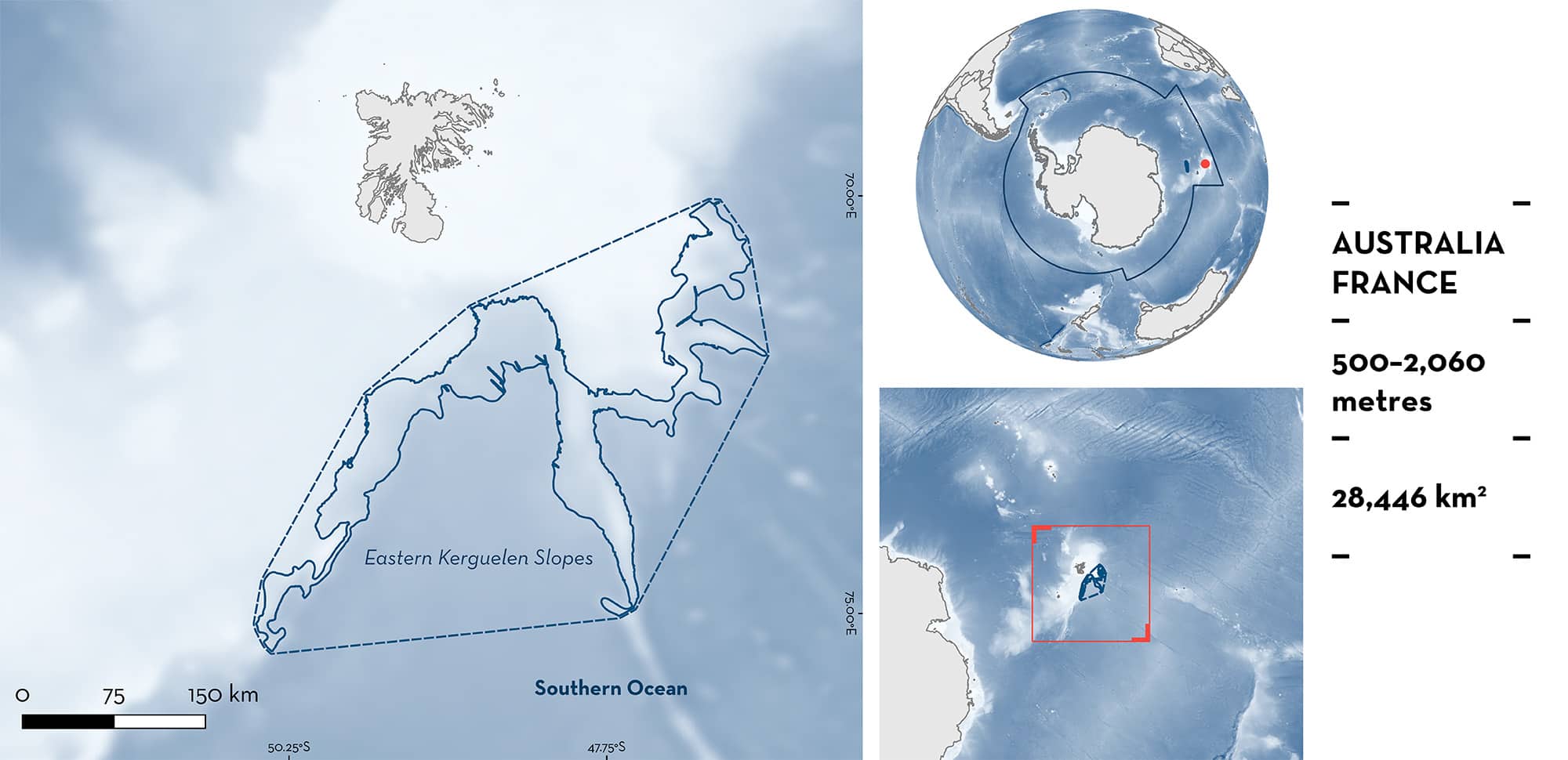ISRA FACTSHEETS
ISRA FACTSHEETS
POLAR WATERS REGION
Eastern Kerguelen Slopes
Summary
Eastern Kerguelen Slopes is located primarily in the French Exclusive Economic Zone (EEZ) and marginally into the Australian EEZ east of the Kerguelen Islands in the Southern Ocean. The northern part of the split Antarctic Circumpolar Current flows eastward through the area. Eastern Kerguelen Slopes is characterised by a deep slope, with canyons, escarpments, ridges, and terraces. The area overlaps with the French National Natural Reserve of the Terres australes françaises and the Australian Heard Island and McDonald Islands Marine Park. Within this area there are: threatened species (Kerguelen Skate Bathyraja irrasa); range-restricted species (Kerguelen Skate); and reproductive areas (Traveller Lanternshark Etmopterus viator).
Download factsheet
Eastern Kerguelen Slopes
DESCRIPTION OF HABITAT
Eastern Kerguelen Slopes is located on the slope east of Kerguelen Islands, ~2,000 km north of Mac Robertson Land, Antarctica, in the Southern Ocean. The area is located primarily in the French Exclusive Economic Zone (EEZ) of Terres australes et antarctiques françaises/French Southern and Antarctic Lands (TAAF), and marginally into the Australian EEZ of Heard Island and McDonald Islands (HIMI). There are canyons, escarpments, ridges, and terraces in this part of the Kerguelen slope.
The main oceanographic influence on the area is the Antarctic Circumpolar Current flowing eastward. It splits at the Kerguelen Plateau, with most of the flow deflected around the northern side, through the area (Park et al. 2008).
The area overlaps with the French National Natural Reserve of the Terres australes françaises and the Australian Heard Island and McDonald Islands Marine Park.
This Important Shark and Ray Area is benthopelagic and subsurface and is delineated from 500 m to 2,060 m based on the depth range of Qualifying Species in the area.
CRITERION A
VULNERABILITY
One Qualifying Species considered threatened with extinction according to the IUCN Red List of Threatened Species regularly occurs in the area. This is the Vulnerable Kerguelen Skate (Dulvy et al. 2020).
CRITERION B
RANGE RESTRICTED
This area holds the regular presence of Kerguelen Skate as a resident range-restricted species. It is incidentally captured in the Patagonian Toothfish Dissostichus eleginoides longline fishery in this area (Nowara et al. 2017; Faure 2023). Data from 2008–2014 included an average of 2,613 hauls per year and recorded ~54,000 Kerguelen Skates, making up the majority (62%) of skate bycatch in this fishery (Nowara et al. 2017). These skates were caught on the slope between 500–2,059 m depth, with a slight peak at ~800 m. Although the species is also captured elsewhere on the Kerguelen Plateau, major hotspots are in this area east of Kerguelen Islands (Nowara et al. 2017; MNHN & TAAF 2020; Faure 2023), indicating that it is an important area for Kerguelen Skates in this region. This species is endemic to the wider Kerguelen Plateau (Last et al. 2016) and is found nowhere else in the Southern Ocean or globally, highlighting its limited range.
CRITERION C
SUB-CRITERION C1 – REPRODUCTIVE AREAS
Eastern Kerguelen Slopes is an important reproductive area for one shark species.
During 2006–2015, Traveller Lanternsharks were the most common shark bycatch recorded by observers monitoring 25% of fishing effort (>55 million hooks checked) of the benthic longline fishery targeting Patagonian Toothfish operating in the area (Chazeau et al. 2019). In total, 29,422 Traveller Lanternsharks were captured, extrapolating from the 25% observer coverage to ~12,000 individuals per year. The species was present in ~18% of hauls and up to 60 individuals (mean of 2.5) were caught per 1,000 hooks. The fishery operates between 500–2,000 m depth, and there was a peak in Traveller Lanternshark catch at 1,200 m depth (Chazeau et al. 2019).
The catch was dominated by females with a sex ratio of 1.4, but females and males were found in the same areas. Similarly, all size classes were found in the same locations, indicating that this is an important area for the whole life cycle of the species. The catch was dominated by juveniles (~90% of the total catch), however the length distribution was bimodal with a second peak at ~52 cm total length (TL) for adults. The second peak was particularly apparent in females, with adult females making up ~15% of the catch of females (Chazeau et al. 2019).
The length-at-first-maturity for females was 48.5 cm TL with pregnant females ranging 48.5–59.5 cm TL aborting late-term embryos (3–13 per female) ranging 15–18 cm TL (Chazeau et al. 2019). This slightly extends the published size-at-birth of ~12–15 cm TL (Ebert et al. 2021). Around 1% of the catch were neonates born or aborted on board, indicating that this is likely to be an important pupping area too. The large hooks used in the fishery meant that neonates and young-of-the-year were not frequently directly captured (Chazeau et al. 2019), however, full-term embryos of pregnant females show that this is an important reproductive area. Traveller Lanternsharks were rarely reported in nearby fisheries at Crozet Islands (Pruvost et al. 2015; C Péron pers. obs. 2024) and only two individuals of the genus were recorded on Elan Banks (Péron et al. 2019), highlighting that Eastern Kerguelen Slopes is an important reproductive area for this species. Further, detailed information on reproductive biology is not available from anywhere else in the scattered Southern Ocean distribution of this species.
Download factsheet
SUBMIT A REQUEST
ISRA SPATIAL LAYER REQUEST
To make a request to download the ISRA Layer in either a GIS compatible Shapefile (.shp) or Google Earth compatible Keyhole Markup Language Zipped file (.kmz) please complete the following form. We will review your request and send the download details to you. We will endeavor to send you the requested files as soon as we can. However, please note that this is not an automated process, and before requests are responded to, they undergo internal review and authorization. As such, requests normally take 5–10 working days to process.
Should you have questions about the data or process, please do not hesitate to contact us.


